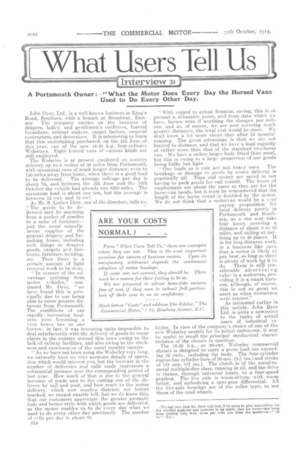at Users Tell Us
Page 16

If you've noticed an error in this article please click here to report it so we can fix it.
John Dyer, Ltd., is a well-known business in King's Road, Southsea, with a branch at Broadway, Eastney. The company carries on the business of drapers, ladies' and gentlemen's outfitters, funeral furnishers, cabinet makers, carpet factors, removal contractors, and decorators. It is interesting to learn that this undertaking purchased, on the 4th June of this year, one of the new 16-20 h.p. four-cylinder Wolseleys. Eight horsed vans of various kinds are still employed.
The Wolseley is at present employed on country delivery up to a radius of 30 miles from Portsmouth, with occasional runs of much longer distance, even to 150 miles away from homee, when there is a good load to be delivered. The average mileage per day is about. 75, and between the 4th June and the 10th October the vehicle had already run 8200 miles. The maximum load is about one ton, but the average is between 12 cwt_ and 15 cwt.
nishing house, including such things as drapery goods, carpets and linoleums, furniture, bedding, etc. Then there is a certain amount of light removal work to be done, "In respect of the advantage accruing from motor vehicles," continued Mr. Dyer, "we have found this is principally due to our being able to cover greater distances from Portsmouth. The conditions of our rapidly increasing business were becoming a very heavy tax on our horses ; in fact, it was becoming quite impossible to deal satisfactorily with the delivery of goods to many Places in the country around this town owing to the lack of railway facilities, and also owing to the slaekness and carelessness of the usual country carrier.
"As we have not been using the Wolseley very long, we naturally have no very accurate details of operation which would interest you, but the increase in the number of deliveries and calls made represents a substantial increase over the corresponding period of last year. How much of that is due to the general increase of trade and to the cutting out of the delivery by rail and Post, and how much to the motor delivery, which now reaches districts not before touched, we cannot exactly tell, but we do know this, that our customers appreciate the greater promptitude and better style with which goods are delivered, as the motor enables us to do every day what we used to do every other day previously. The number of enlls per day is about 60.
" With regard to actual financial sa■ ing, this is at present a debatable point, and from data which we have, horses were if anything the cheaper per mile run, and as, of course, we are now covering much greater distances, the total cost would be more. We shall know a lot more about that after 12 months' running. The great advantage is that we are not limited to distance, and that we have a load capacity of rather more than that f the standard two-horse van. We have a rather larger body fitted than usual, but this is owing to a large proportion of our goods being bulky but. light.
'Our loads as a rule are not heavy ones. The breakage or damage to goods by motor delivery is practically nil. Time and money are saved in not having to pack goods for rail transit. The hours of employment are about the same as they are for the horse-van hands, but it must. be remembered that the length of the horse round is doubled by the motor. We do not think that a motorvan would be a very paying proposition iefori local delivery purely n Portsmouth and South. sea, as a run may take four hours, covering a distance of about 8 to 10 miles, and calling at anything up to 40 places. It is for long-distance work, in a business like ours, that a motor is likely to pay best, so long as there is plenty of work for it to do. There is still considerable advert ising value in a niotorvan, providing it is a smart turnout, although, of course, this is not so great an asset as when motorvans were scarcer."
As intimated earlier in this article, John Dyer Ltd. is quite a newcomer to the ranks of actual users of industrial vehicles. In view of the company's choice of one of the new Wolseley models for its initial endeavour, it may he useful to recall the principal mechanical characteristics of the chassis in question.
The 16-20 h.p., or 20-cwt. Wolseley commercial chassis is designed to carry a gross load not exceeding 32 ewts., including the body. The four-cylinder engine has cylinder-bore of 90 mm. (319,T ins.) and stroke of 121 mm. (4i ins.). The clutch is of the metal-tometal multiple-disc class, running in oil, and the drive is thence, through universal joints, to a four-speed gearbox. The live axle is worm-driven, with worni below, and embodying a spur-gear differential. All the live-axle bearings are of the roller type, as are those of the road wheels. ........................................






















